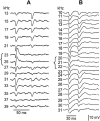Inhibitory projections from the ventral nucleus of the lateral lemniscus and superior paraolivary nucleus create directional selectivity of frequency modulations in the inferior colliculus: a comparison of bats with other mammals
- PMID: 20451594
- PMCID: PMC4317268
- DOI: 10.1016/j.heares.2010.03.083
Inhibitory projections from the ventral nucleus of the lateral lemniscus and superior paraolivary nucleus create directional selectivity of frequency modulations in the inferior colliculus: a comparison of bats with other mammals
Abstract
This review considers four auditory brainstem nuclear groups and shows how studies of both bats and other mammals have provided insights into their response properties and the impact of their convergence in the inferior colliculus (IC). The four groups are octopus cells in the cochlear nucleus, their connections with the ventral nucleus of the lateral lemniscus (VNLL) and the superior paraolivary nucleus (SPON), and the connections of the VNLL and SPON with the IC. The theme is that the response properties of neurons in the SPON and VNLL map closely onto the synaptic response features of a unique subpopulation of cells in the IC of bats whose inputs are dominated by inhibition. We propose that the convergence of VNLL and SPON inputs generates the tuning of these IC cells, their unique temporal responses to tones, and their directional selectivities for frequency modulated (FM) sweeps. Other IC neurons form directional properties in other ways, showing that selective response properties are formed in multiple ways. In the final section we discuss why multiple formations of common response properties could amplify differences in population activity patterns evoked by signals that have similar spectrotemporal features.
Copyright © 2010 Elsevier B.V. All rights reserved.
Figures







Similar articles
-
Differential ascending projections to aural regions in the 60 kHz contour of the mustache bat's inferior colliculus.J Neurosci. 1989 Aug;9(8):2819-34. doi: 10.1523/JNEUROSCI.09-08-02819.1989. J Neurosci. 1989. PMID: 2549219 Free PMC article.
-
Conserved mechanisms of vocalization coding in mammalian and songbird auditory midbrain.Hear Res. 2013 Nov;305:45-56. doi: 10.1016/j.heares.2013.05.005. Epub 2013 May 31. Hear Res. 2013. PMID: 23726970 Free PMC article.
-
The dominant role of inhibition in creating response selectivities for communication calls in the brainstem auditory system.Hear Res. 2013 Nov;305:86-101. doi: 10.1016/j.heares.2013.03.001. Epub 2013 Mar 29. Hear Res. 2013. PMID: 23545427 Free PMC article. Review.
-
The superior paraolivary nucleus shapes temporal response properties of neurons in the inferior colliculus.Brain Struct Funct. 2015 Sep;220(5):2639-52. doi: 10.1007/s00429-014-0815-8. Epub 2014 Jun 29. Brain Struct Funct. 2015. PMID: 24973970 Free PMC article.
-
Roles of inhibition for transforming binaural properties in the brainstem auditory system.Hear Res. 2002 Jun;168(1-2):60-78. doi: 10.1016/s0378-5955(02)00362-3. Hear Res. 2002. PMID: 12117510 Review.
Cited by
-
Neural modelling of the encoding of fast frequency modulation.PLoS Comput Biol. 2021 Mar 3;17(3):e1008787. doi: 10.1371/journal.pcbi.1008787. eCollection 2021 Mar. PLoS Comput Biol. 2021. PMID: 33657098 Free PMC article.
-
A Computational Model of Auditory Chirp-Velocity Sensitivity and Amplitude-Modulation Tuning in Inferior Colliculus Neurons.Res Sq [Preprint]. 2024 Jun 4:rs.3.rs-4450943. doi: 10.21203/rs.3.rs-4450943/v1. Res Sq. 2024. Update in: J Comput Neurosci. 2024 Nov;52(4):285-302. doi: 10.1007/s10827-024-00880-4. PMID: 38883707 Free PMC article. Updated. Preprint.
-
GABA is a modulator, rather than a classical transmitter, in the medial nucleus of the trapezoid body-lateral superior olive sound localization circuit.J Physiol. 2019 Apr;597(8):2269-2295. doi: 10.1113/JP277566. Epub 2019 Mar 12. J Physiol. 2019. PMID: 30776090 Free PMC article.
-
Slow NMDA-Mediated Excitation Accelerates Offset-Response Latencies Generated via a Post-Inhibitory Rebound Mechanism.eNeuro. 2019 Jun 18;6(3):ENEURO.0106-19.2019. doi: 10.1523/ENEURO.0106-19.2019. Print 2019 May/Jun. eNeuro. 2019. PMID: 31152098 Free PMC article.
-
Minimal Number of Required Inputs for Temporally Precise Action Potential Generation in Auditory Brainstem Nuclei.Front Cell Neurosci. 2020 Nov 5;14:592213. doi: 10.3389/fncel.2020.592213. eCollection 2020. Front Cell Neurosci. 2020. PMID: 33250717 Free PMC article.
References
-
- Adams JC. Projections from octopus cells of the posteroventral cochlear nucleus to the ventral cochlear nucleus of the lateral lemniscus of the cat and human. Aud. Neurosci. 1997;4:335–350.
-
- Barber JR, Razak KA, Fuzessery ZM. Can two streams of auditory information be processed simultaneously? Evidence from the gleaning bat Antrozous pallidus. J. Comp. Physiol. A Neuroethol. Sens. Neural Behav. Physiol. 2003;189:843–855. - PubMed
-
- Bauer EE, Klug A, Pollak GD. Spectral determination of responses to species-specific calls in the dorsal nucleus of the lateral lemniscus. J. Neurophysiol. 2002;88:1955–1967. - PubMed
-
- Behrend O, Brand A, Kapfer C, Grothe B. Auditory response properties in the superior paraolivary nucleus of the gerbil. J. Neurophysiol. 2002;87:2915–2928. - PubMed
Publication types
MeSH terms
Grants and funding
LinkOut - more resources
Full Text Sources

